




 |
 9-04. Sewage Treatment Network Screen Room
9-04. Sewage Treatment Network Screen Room |
 |
1. Welcome to the Seonam sewage treatment plant.
It is a pleasure to have you with us here today. Water of which the history began with the birth of the earth is both the origin of all lives including humans, and a necessary and important source of human life in the past, present and future. |
|
2. Water grows flowers and trees, with its dewdrops, ripens crops and fruits, and makes
us enjoy the joy and richness of harvest in the autumn. And it quenches the thirst of man, and is used not only in cooking but also in transportation of goods and productive activities in industry. |
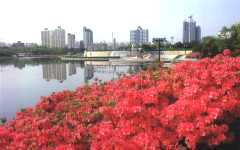 |
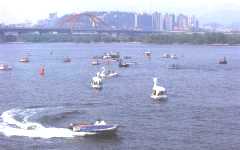 |
3. But water we use always becomes polluted. As the amount of water used increased
by population increase, industrialization and urbanization after 1960's, the amount of
pollutants grew and water pollution. become more serious. Therefore when we return used water to nature, we must purify it. It is the sewage treatment plant that is in charge of purifying contaminated water. |
|
4. Leaves in the forests die, fall on the earth and rot when autumn comes. The rotten
leaves contaminate brooks in the forest with organisms. But, while the brook flows down ward, it becomes clean naturally. This is called self-purification. This phenomenon occurs because microorganisms in water decompose the organisms to obtain nutrients and energy needed for growth. |
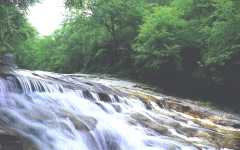 |
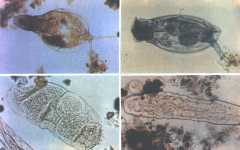 |
5. Using this principle, sewage treatment treats a lot of sewage in a short time, by
cultivating many microorganisms. This sewage treatment method is called conventional activated sludge process. Because it does n`t use chemicals, it is used widely as a safe method without secondary pollution. |
|
6. Seoul city treats sewage by the conventional activated sludge process, and has
constructed sewage treatment plants to prevent water pollution of Han river, which is
the lifeline of the people and driving force of economic development. In 1976 when economic development was at its height, Chong-Gye Chun sewage treatment plant with a capacity of about 150,000tons of sewage a day was first completed in our we country and began modern sewage treatment. |
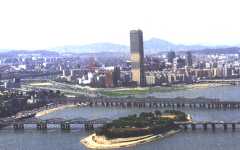 |
 |
7. After that, Seoul city continued to construct sewage treatment plants, and now there
are four sewage treatment plants in Jung-Rang, Tan-cheon, Ga-Yang, and Nan-Ji. With Han-river Complex Development, Seoul city installed sewer facilities on the river banks and made water used by Seoul citizens flow into the four sewage treatment plants. |
|
8. The capacity of sewage treatment facility was 150,000ton a day in 1976, and a total of
3,710,000ton in 1995. |
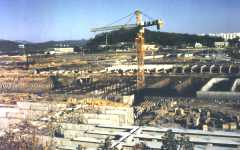 |
 |
9. The place where you have come to see is the Seonam sewage treatment plant.
Seonam sewage treatment plant is located is Ma-gok dong of Gang-So Gu, Seoul, Korea And has a total area of 1,065,000 square meters with 2,000,000 ton sewage treatment facility and 2,000 ton septic tank sludge treatment facility and is operated day and night for 24 hours in 3 cycles. |
|
10. It's treatment covers 9 districts and a city, namely Tongjak, Kwanak,
Young Deung Po, Kuro, KumChun, Kangsu GU, and parts of Kangnam, Seocho GU and
Kwang Myung city. Its main facility are water treatment facility which purify sewage and discharge it to the Han-river, and sludge treatment facility handling wastes produced in water treatment facilities. Now let us look into the treatment. |
 |
 |
11. process in our sewage treatment plant.
The sewage produced in each house flows into grit chamber through sewer line . The role of grit chamber is to sink sands mixed in the sewage to eliminate them, and to prevent blocking and trouble in all devices in the next process, eliminating such matters as vinyl, splinters, plastics and luminum by screens installed before and behind the grit chamber. |
|
12. Because the sewage produced in each house flows naturally through a long sewer
line, its surface is much lower when it comes to our treatment plant. |
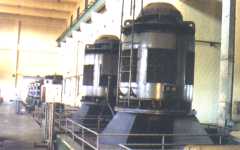 |
 |
13. The primary settling tanks makes sewage stay for about 2 hours and settles
suspended solid sinkable. At this time pollutants like biochemical oxygen demand and suspended solids are eliminated to about 30 - 35%. The water from the primary settling tank is sent to aeration tank. |
|
14. Aeration tank is the most important in the process of sewage treatment and are the
place to decompose most pollutants. |
 |
 |
15. While staying in aeration tank for about 6 hours, the water inflow from primary
settling tank contacts micro organisms in aeration tanks and the microorganisms
decompose pollutants. At this time micro organisms, are too small to be seen, but they exist in small particles, making flocs flow into final settling tank mixed with pured water. |
16. After final settling tank makes the mixture from aeration tank, stay for about 3
and a half hours and sinks micro organism flocs, they return flocs to aeration tanks to
provide microorganisms for aeration tanks, and remaining micro organism flocs are sent
to thickener as excess sludge. |
 |
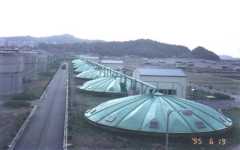 |
17. The waste produced in water treatment facilities is treated in sludge treatment
process. In the first place the waste of raw sludge sunk in primary settling tanks and sent to thickener by pumps. Thickener makes sludge stay for about 12 hours and helps raise digestion and dehydration efficiency in the next process, making it thickened sludge in 96% water content by gravitation. |
18. Thickened sludge is sent to digestion tanks. |
 |
 |
19. The methane gas is used for fuel of generator and boiler, after eliminating sulfur by
means of desulfuration device. Digested sludge is sent to dehydrators after being thickened in about 95% water content in secondary digestion tanks. |
20. The dehydrators are in a belt press type, they dehydrate sludge and make it a cake
in about 75% water content, the sludge cake is sent to Kimpo landfill by truck. |
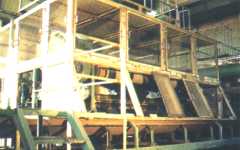 |
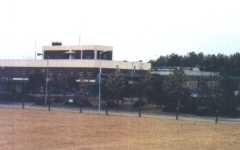 |
21. Every house has a septic tank to treat feces and urine, and it shows efficiency
when cleaned once a year. At this time waste collected by truck is called septic tank sludge. It is sent to digestion facilities in the sewage treatment plant after filtering adulterations and being thickened in septic tank sludge treatment facilities. |
22. And the upper part of the thickener is sent to the grit chamber in sewage treatment
plant and is mixed and treated with sewage. |
 |
 |
23. The central control system in the head quaters of Seonam sewage treatment
plant watches the operation state of each spot 24 hours a day, automates the treatment
facilities, and records, stores and controls all data about treatment state and applies
them to efficient sewage treatment. At the laboratory, we analyze water quality in each process precisely, and this makes assurance double sure in sewage treatment. |
|
24. Besides, the facilities in sewage treatment plant is used as a nature studying place
for students and citizens And as conference room, tennis court, and park in the sewage
treatment plant are open to neighboring residents, they are used as convenient facilities.
|
 |
 |
25. Water is the most valuable and most important source of life in the world.
But contaminated water does harm to man and destroys natural environment. Therefore to prevent water pollution when we pour out sewage we must mind the followings. |
|
26. First, adulterations like splinters and vinyls should not be then away in a ditch.
These adulterations not only block ditches, but also cause trouble in devices. |
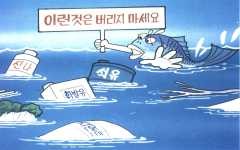 |
 |
27. Third, food refuse should not be thrown away into dustbins before squeezing water
from it and detergent powder should be used in optimum quantity. Food refuse and detergent are causes of worsening water quality because they are not decomposed easily. Fourth, sewage amount should be reduced by saving water. If a person saves 20ℓ of water a day, we can save 730 billion won in national budget including 150 billion won for sewage treatment spending and, 580 billion won for tap water producing spent in a year. |
28. Our country is famous for beautiful mountains and rivers from ancient times. It is
our duty to keep the valuable water clean and hand it down to our descendants. |
 |
 Sewage Data Room Main Menu
Sewage Data Room Main Menu
|